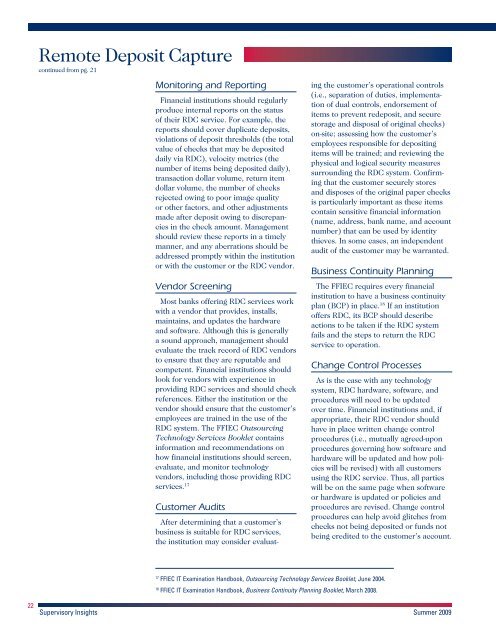FDIC Supervisory Insights Summer 2009
FDIC Supervisory Insights Summer 2009
FDIC Supervisory Insights Summer 2009
Create successful ePaper yourself
Turn your PDF publications into a flip-book with our unique Google optimized e-Paper software.
Remote Deposit Capture<br />
continued from pg. 21<br />
Monitoring and Reporting<br />
Financial institutions should regularly<br />
produce internal reports on the status<br />
of their RDC service. For example, the<br />
reports should cover duplicate deposits,<br />
violations of deposit thresholds (the total<br />
value of checks that may be deposited<br />
daily via RDC), velocity metrics (the<br />
number of items being deposited daily),<br />
transaction dollar volume, return item<br />
dollar volume, the number of checks<br />
rejected owing to poor image quality<br />
or other factors, and other adjustments<br />
made after deposit owing to discrepancies<br />
in the check amount. Management<br />
should review these reports in a timely<br />
manner, and any aberrations should be<br />
addressed promptly within the institution<br />
or with the customer or the RDC vendor.<br />
Vendor Screening<br />
Most banks offering RDC services work<br />
with a vendor that provides, installs,<br />
maintains, and updates the hardware<br />
and software. Although this is generally<br />
a sound approach, management should<br />
evaluate the track record of RDC vendors<br />
to ensure that they are reputable and<br />
competent. Financial institutions should<br />
look for vendors with experience in<br />
providing RDC services and should check<br />
references. Either the institution or the<br />
vendor should ensure that the customer’s<br />
employees are trained in the use of the<br />
RDC system. The FFIEC Outsourcing<br />
Technology Services Booklet contains<br />
information and recommendations on<br />
how financial institutions should screen,<br />
evaluate, and monitor technology<br />
vendors, including those providing RDC<br />
services. 17<br />
Customer Audits<br />
After determining that a customer’s<br />
business is suitable for RDC services,<br />
the institution may consider evaluat-<br />
ing the customer’s operational controls<br />
(i.e., separation of duties, implementation<br />
of dual controls, endorsement of<br />
items to prevent redeposit, and secure<br />
storage and disposal of original checks)<br />
on-site; assessing how the customer’s<br />
employees responsible for depositing<br />
items will be trained; and reviewing the<br />
physical and logical security measures<br />
surrounding the RDC system. Confirming<br />
that the customer securely stores<br />
and disposes of the original paper checks<br />
is particularly important as these items<br />
contain sensitive financial information<br />
(name, address, bank name, and account<br />
number) that can be used by identity<br />
thieves. In some cases, an independent<br />
audit of the customer may be warranted.<br />
Business Continuity Planning<br />
The FFIEC requires every financial<br />
institution to have a business continuity<br />
plan (BCP) in place. 18 If an institution<br />
offers RDC, its BCP should describe<br />
actions to be taken if the RDC system<br />
fails and the steps to return the RDC<br />
service to operation.<br />
Change Control Processes<br />
As is the case with any technology<br />
system, RDC hardware, software, and<br />
procedures will need to be updated<br />
over time. Financial institutions and, if<br />
appropriate, their RDC vendor should<br />
have in place written change control<br />
procedures (i.e., mutually agreed-upon<br />
procedures governing how software and<br />
hardware will be updated and how policies<br />
will be revised) with all customers<br />
using the RDC service. Thus, all parties<br />
will be on the same page when software<br />
or hardware is updated or policies and<br />
procedures are revised. Change control<br />
procedures can help avoid glitches from<br />
checks not being deposited or funds not<br />
being credited to the customer’s account.<br />
17 FFIEC IT Examination Handbook, Outsourcing Technology Services Booklet, June 2004.<br />
18 FFIEC IT Examination Handbook, Business Continuity Planning Booklet, March 2008.<br />
22 <strong>Supervisory</strong> <strong>Insights</strong> <strong>Summer</strong> <strong>2009</strong>

















